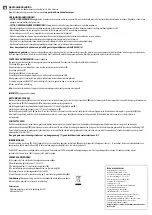
Fault Finding
95
9.3 ALARMS
Symptom
Possible Remedy
Low oil Pressure fault
operates after engine has
fired
Check engine oil pressure. Check oil pressure switch/sensor and
wiring. Check configured polarity (if applicable) is correct (i.e.
Normally Open or Normally Closed) or that sensor is compatible with
the module and is correctly configured.
High engine temperature fault
operates after engine has
fired.
Check engine temperature. Check switch/sensor and wiring. Check
configured polarity (if applicable) is correct (i.e. Normally Open or
Normally Closed) or that sensor is compatible with the module.
Shutdown fault operates
Check relevant switch and wiring of fault indicated on LCD display.
Check configuration of input.
Electrical Trip fault operates
Check relevant switch and wiring of fault indicated on LCD display.
Check configuration of input.
Warning fault operates
Check relevant switch and wiring of fault indicated on LCD display.
Check configuration of input.
CAN ECU WARNING
CAN ECU SHUTDOWN
This indicates a fault condition detected by the engine ECU and
transmitted to the DSE controller.
CAN DATA FAIL
Indicates failure of the CAN data link to the engine ECU.
Check all wiring and termination resistors (if required).
Incorrect reading on Engine
gauges
Fail to stop alarm when
engine is at rest
Check engine is operating correctly. Check sensor and wiring paying
particular attention to the wiring to terminal 10 (refer to appendix).
Check that sensor is compatible with the module and that the
module configuration is suited to the sensor.
9.4 COMMUNICATIONS
Symptom
Possible Remedy
CAN DATA FAIL
Indicates failure of the CAN data link to the engine ECU.
Check all wiring and termination resistors (if required).
9.5 INSTRUMENTS
Symptom
Possible Remedy
Inaccurate generator
measurements on controller
display
Check that the CT primary, CT secondary and VT ratio settings are
correct for the application.
Check that the CTs are wired correctly with regards to the direction
of current flow (p1,p2 and s1,s2) and additionally ensure that CTs
are connected to the correct phase (errors occur if CT1 is connected
to phase 2).
Remember to consider the power factor (kW = kVA x powerfactor).
The controller is true RMS measuring so gives more accurate
display when compared with an ‘averaging’ meter such as an
analogue panel meter or some lower specified digital multimeters.
Accuracy of the controller is better than 1% of full scale. Generator
voltage full scale is 415V ph-N, accuracy is ±4.15V (1% of 415V).
Summary of Contents for DSE7110 MKII
Page 34: ...Installation 34 4 2 1 DSE7110 MKII TYPICAL WIRING DIAGRAM 3 PHASE 4 WIRE ...
Page 35: ...Installation 35 4 2 2 DSE7120 MKII TYPICAL WIRING DIAGRAM 3 PHASE 4 WIRE ...
Page 36: ...Installation 36 4 3 ALTERNATE TOPOLOGY WIRING DIAGRAMS 4 3 1 GENERATOR ...
Page 37: ...Installation 37 4 3 2 MAINS DSE7120 MKII ONLY ...






































